Meaning and History of Accounting Standards
Wherever and whenever if we discuss about accounting, By definition, it is universally accepted that it’s a systematic process of identifying, recording, measuring, classifying, verifying, summarizing, interpreting and communicating financial information. It can be said that the process of identifying, recording, measuring etc of the financial transactions are basically for communicating the information. That’s why it is said as the language of accounting. If we go back to the history of accounting, According to Marla Matzer Rose, author of Accounting & Auditing History, it’s a time of early 2000 to 3300 BC, the earliest known writing discovered by archaeologists has, when translated, been found to be records of tax accounting. Such writings have been found on clay tablets from Egypt and Mesopotamia. But later on, the innovative Italians of the Renaissance (fourteenth through sixteenth century) particularly Benedetto Cotrugli who invented the “Double Entry” and Frater Luca Bartolomes Pacioli who invented Pacioli’s System of memorandum, journal and ledger are the pioneer of accounting and are widely acknowledged to be the fathers of modern accounting.
Accounting Standards are set of guidelines & principles formulated by an authorized body for preparation & presentation of financial statements. These are the detailed guides for interpretations of issues, terms, accounting treatments of specific items on uniform base to be used by organizations, accounting people and auditors. Therefore, accounting has been called the language of business and accounting standards are grammar of this language. Accounting information has been useful for hundreds of years and must have a solid grounding in its fundamentals.
The concept of harmonization of the accounting procedure first arose in the late 1950s in response to post World War II economic integration and related increases in cross-border capital flows. Initially the effort was focused on harmonization—reducing differences among the accounting principles used in major capital markets around the world. By the 1990s, the notion of harmonization was replaced by the concept of convergence—the development of a unified set of high-quality, international accounting standards that would be used in at least all major capital markets. The International Accounting Standards Committee, formed in 1973, was the first international standards-setting body. It was reorganized in 2001 and became an independent international standard setter, the International Accounting Standards Board (IASB). Since then, the use of international standards has progressed. Different institutions/committees related to accounting profession have been working and formulating the standards for the uniformity of the financial information. The IASB (International Accounting Standards Board), IASCF (International Accounting Standards Committee Foundation), IASC (International Accounting Standards Committee), IFAC (International Federation of Accountants) are the major institutions working towards it.
International Financial Reporting Standards (IFRS) is a set of accounting standards developed by International Accounting Standards Board (IASB). As of 2013, the European Union and more than 100 other countries either require or permit the use of such standards issued by the IASB or a local variant of them. The goal of IFRS is to provide a global framework for how public companies prepare and disclose their financial statements. IFRS provides general guidance for the preparation of financial statements, rather than setting rules for industry-specific reporting. Having an international standard is especially important for large companies that have subsidiaries in different countries. Adopting a single set of world-wide standards will simplify accounting procedures by allowing a company to use one reporting language throughout.
Why IFRS
In the 19th century, as the stock companies became more popular, shareholders-owners emerged without sufficient knowledge of enterprise operations along with employed administration staff periodically in need of reporting to the owners. The necessity arose for reporting of such information that would be understandable to the shareholders and comparable to the reporting data of other enterprises. Therefore, the necessity itself took the initiation to form standards in local level. In this way national accounting system has been introduced and now any national accounting system in the world is independent and is protecting the national interests of the country. Influence of the leading theory writers and professional accountancy bodies, economic consequences arising from adopted systems, general economic situation in the country, tax policy, national peculiarities, users of financial data and their goals, legal environment, sources of financing, language, the general dominating atmosphere in the country are the factors defining the peculiarities of national accounting system. All of the currently adopted accounting standards can be conditionally grouped in the following categories pursuant to the degree of standardization of accounting:
– National standards, the application of which is statutory in a specific country;
– National standards, the application of which is statutory in countries of specific regions;
– International financial reporting standards which are developed for application in countries worldwide.
Such influence through local factors definitely creates the diversity in the procedures. To avoid such diversity and maintain the uniformity throughout the globe standards are set. Therefore, the purpose of establishing the international financial reporting standards is the harmonization of national accounting and reporting systems in order to improve the quality of use of the company financing, and particularly of the trans-national companies.
IAS vs. IFRS
Some of us may not know why we are talking about IFRS because we already have IAS (International Accounting Standards) and we are following it from number of years. Some of us may not know what the difference between IAS and IFRS is. If we review the evolution of Accounting Standards from the time when IASC was established, it will be easy to mark the differences. In mid 1973, the IASC was established; mandated with releasing new international standards, which would be rapidly accepted and implemented worldwide. The ISAC lasted 27 years until the year 2001, when it was restructured to become the IASB.
A series of accounting standards, known as the International Accounting Standards, were released by the IASC between 1973 and 2000, and were ordered numerically. The series started with IAS 1, and concluded with the IAS 41, in December 2000. At the time when the IASB was established, they agreed to adopt the set of standards that were issued by the IASC, i.e. the IAS 1 to 41, but that any standards to be published after that would follow a series known as the International Financial Reporting Standards (IFRS). Technically IAS and IFRS are the same, but they are different when analyzed carefully. IFRS is the standards that are made by keeping in mind the changes on the financial market, business and the economical environment over the last 20 years. It is interesting to know that only few IFRS are issued so far and the IAS that has not been modified is in regular use today also. Hence, it is not good to state IAS as outdated though there are no chances of IASB issuing IAS in future. Any standards that will be issued in the future will be said as IFRS and if it clashes with any of the existing IAS then IFRS will be put to use.
IAS and IFRS both help common people to practically know the financial statements of a company even if it operates in other country. This will give a fair idea of the administration of a company. It should be seriously noted that IASB do not have powers to compel a company to use the IFRS and IAS but the national regulatory would make it mandatory for public entities in respective country.
IFRS in our context
Recently the Institute of Chartered Accountants of Nepal (ICAN), the governing institutions in profession has announced to implement NFRS (Nepal Financial Reporting Standards) which are prepared in line with the IFRS. According to the notice of ICAN, Some of the organizations like multinational companies and state owned entities should implement the NFRS initially from financial year 2014-15 and gradually more organizations will be entered. It is noted that up to financial year 2016-17 all the organizations should implement it.
The discussion over the topic ‘IFRS’ has been started from 2067 BS when the council has decided to implement the standards in listed companies. But those companies were not fully prepared so the implementation has been shifted making stakeholders of such implementation aware about it. Now we have the schedule for the implementation.
Like other entities in the country, EPF being the state owned entity, have to implement the IFRS from financial year 2016-17. To implement IFRS the EPF itself has to be aware about it. The awareness and the training regarding such standards make us fully prepared. We don’t have the choice to let down the implementation. Therefore, later on while implementing it, shortages of the skilled professionals/human recourses and the proper organizational action plan should not be the bottleneck. We have sufficient time and during such time we can train our people making them aware and formulate action plan for the implementation of the standards.
Here we have to go.
Reference:
Institute of Professional Financial Managers London, UK Applying International Financial Reporting Standards.
Government of Nepal. (Nov, 2011). Nepal PortfolioPerformance Review Nppr 2011. Retrieved February 17, 2012 from http://siteresources.worldbank.org/NEPALEXTN/Resources/223554-1296055463708/NPPR2011.pdf
Nepal Rastra Bank. (2003). Banking supervision. Retrieved February 22, 2009, from http://www.nrb.org.np/bsd/reports/Annual_Reports– Annual_Bank_Supervision_Report_2002-2003.pdf
World Bank. (April, 2005). Corporate governance: Country assessment: Nepal. Retrieved February 22, 2009, from http://www.worldbank.org/ifa/rosc_cg_nepal.pdf
Lok Man Maskey, 2068, Hand Book on IFRSs




